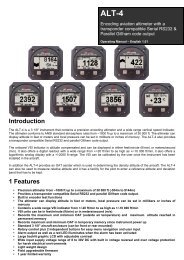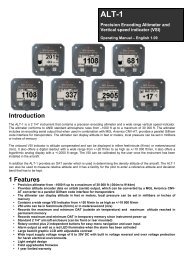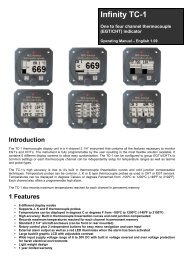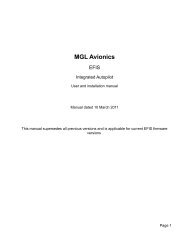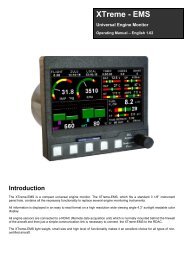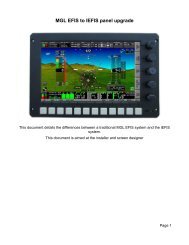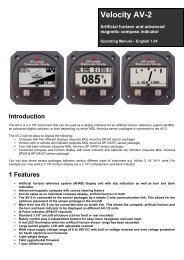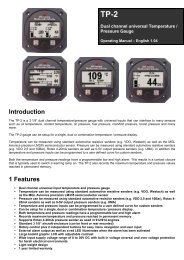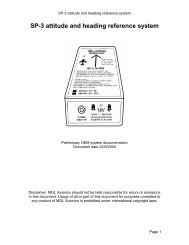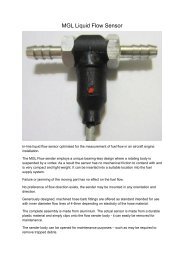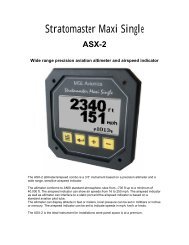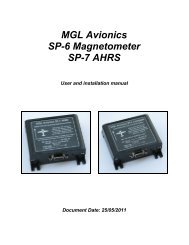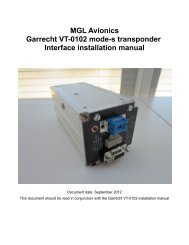Enigma Airspace file format - MGL Avionics
Enigma Airspace file format - MGL Avionics
Enigma Airspace file format - MGL Avionics
You also want an ePaper? Increase the reach of your titles
YUMPU automatically turns print PDFs into web optimized ePapers that Google loves.
<strong>Enigma</strong> <strong>Airspace</strong> <strong>file</strong> <strong>format</strong><br />
This document describes the <strong>Enigma</strong> airspace <strong>file</strong> <strong>format</strong>.<br />
This <strong>file</strong> <strong>format</strong> has been created to support the <strong>Enigma</strong> series of EFIS instruments from <strong>MGL</strong><br />
<strong>Avionics</strong>.<br />
<strong>MGL</strong> <strong>Avionics</strong> grants any interested party the right to use this airspace <strong>format</strong> whether this is<br />
in support of a <strong>MGL</strong> <strong>Avionics</strong> product or not.<br />
Any party making use of this document and described <strong>file</strong> <strong>format</strong> will do so at their own<br />
discretion, responsibility and risk.<br />
The party further acknowledges that any data it receives howsoever in this <strong>format</strong> may be<br />
faulty, incorrect, incomplete or outdated and that the party bears responsibility for any<br />
consequence that may arise out of this.<br />
Data may have been compiled from untraceable sources and is included without assumptions<br />
of fitness for any purpose. All data should be treated with circumspection and verified with<br />
independent sources before acceptance and use.<br />
<strong>MGL</strong> <strong>Avionics</strong> places this document and the data <strong>format</strong> it describes in the public domain in<br />
order to foster the use of a common, compact airspace <strong>file</strong> <strong>format</strong> that is particularly optimized<br />
for use with resource limited systems and/or systems that require fast access to individual<br />
items in the airspace <strong>file</strong> in order to increase overall systems performance.<br />
In order to allow recognition of the <strong>format</strong> any party adopting this <strong>format</strong> agrees to refer to this<br />
<strong>format</strong> as the “<strong>Enigma</strong> <strong>Airspace</strong> <strong>format</strong>”. All data using this <strong>format</strong> should be considered to be<br />
in the public domain and the implementer will make reasonable effort to allow any interested<br />
party to use the data free of cost with the exception of a reasonable fee for distribution and<br />
media.<br />
Exceptions:<br />
<strong>MGL</strong> <strong>Avionics</strong> reserves copyright and denies use of this data <strong>format</strong> for any military or related<br />
purpose.<br />
Comments are welcome: info@<strong>MGL</strong><strong>Avionics</strong>.co.za
<strong>Airspace</strong> <strong>format</strong><br />
The airspace <strong>file</strong> has a fixed name when used with an instrument, however any <strong>file</strong> name<br />
could be used. The default <strong>file</strong>name is “AIRSPACE.EVD”. “.EVD” is the general <strong>file</strong> extension<br />
to describe a <strong>Enigma</strong> vector data <strong>file</strong>.<br />
The airspace <strong>file</strong> contains regions, controlled airspaces and special use airspaces.<br />
Within this <strong>file</strong> an unrestricted number of airspace records are stored.<br />
Each airspace record contains a fixed size data portion, a flexible size data portion and a list<br />
of points that form a regular, non-self intersecting polygon describing the location and outline<br />
of the airspace. Each airspace may be defined using more than one polygon. A typical<br />
example of where this is used is if an airspace crosses the date line (E180 to W180). In order<br />
to simplify processing of such airspaces, two airspaces are defined, one in the eastern, the<br />
other in the western hemisphere. Please note that your software must be able to handle the<br />
definition of the bounding rectangle crossing the date line. This is indicated by the North West<br />
longitude having a positive value while the South East longitude has a negative value.<br />
Each airspace record has the following <strong>format</strong>:<br />
Type longint. The type of airspace for this record. Format see below.<br />
Note: also used at the start of the <strong>file</strong> to indicate optional <strong>file</strong><br />
options. See text on <strong>file</strong> options in this document.<br />
North West Lat longint. North West latitude of a bounding rectangle.<br />
North West Long longint. North West longitude of a bounding rectangle.<br />
South East Lat longint. South East latitude of a bounding rectangle.<br />
South East Long longint. South East longitude of a bounding rectangle.<br />
Pointer Next longint. Pointer to next record in <strong>file</strong>.<br />
Pointer Points longint. Pointer to points of the polygon.<br />
Frequency 1 longint. Contact frequency in Khz.<br />
Frequency 2 longint. Alternate contact frequency in Khz.<br />
Upper Altitude longint. Upper altitude limit for airspace. Format see below.<br />
Lower Altitude longint. Lower altitude limit for airspace. Format see below.<br />
ICAO string. ICAO designation for airspace.<br />
Name string. Name of airspace.<br />
Class string. <strong>Airspace</strong> class if not special use airspace.<br />
Exception string. Optional qualification for airspace.<br />
Comm-name string. Radio contact name or phrase.<br />
Level string. Qualifier for upper/lower altitude.<br />
Times string. Operating time or time based restrictions.<br />
Weather string. Weather related restrictions.
-start of polygon points data-<br />
Size longint. Total number of points in polygon(s).<br />
Latitude[Size],Longitude[Size] array of longint pairs describing points of polygon.<br />
Data types<br />
Type<br />
Lat=200.0, long=0: end current polygon, start new polygon.<br />
If the type identifier is the first item in the <strong>file</strong> (at <strong>file</strong> address bytes 0-3), the type may be a<br />
standard type identified by bits 8-31 all zeros. In this case the <strong>file</strong> contains a linear list of<br />
airspaces.<br />
If the type identifier equals the value 0xFFFF0001 the <strong>file</strong> is a tiled airspace <strong>file</strong>. See text on<br />
tiled airspace <strong>file</strong>s in this document.<br />
If bits 8 to 31 are zero, we have a standard airspace type identifier as follows:<br />
Regions, controlled and uncontrolled airspaces<br />
01 - ADVISORY AREA (ADA) OR (UDA)<br />
02 - AIR DEFENSE IDENTIFICATION ZONE (ADIZ)<br />
03 - AIR ROUTE TRAFFIC CONTROL CENTER (ARTCC)<br />
04 - AREA CONTROL CENTER (ACC)<br />
05 - BUFFER ZONE (BZ)<br />
06 - CONTROL AREA (CTA) (UTA)<br />
SPECIAL RULES AREA (SRA, U.K. ONLY)<br />
07 - CONTROL ZONE (CTLZ)<br />
SPECIAL RULES ZONE (SRZ, U.K. ONLY)<br />
MILITARY AERODROME TRAFFIC ZONE (MATZ, U.K. ONLY)<br />
08 - FLIGHT INFORMATION REGION (FIR)<br />
09 - OCEAN CONTROL AREA (OCA)<br />
10 - RADAR AREA<br />
11 - TERMINAL CONTROL AREA (TCA) OR (MTCA)<br />
12 - UPPER FLIGHT INFORMATION REGION (UIR)<br />
Special use airspaces<br />
32- ALERT<br />
33 - DANGER<br />
34 - MILITARY OPERATIONS AREA<br />
35 - PROHIBITED<br />
36 - RESTRICTED<br />
37 - TEMPORARY RESERVED AIRSPACE<br />
38 - WARNING<br />
Latitude and longitude<br />
Latitude and longitude follow the standard <strong>Enigma</strong> <strong>format</strong> as follows:<br />
Position latitude and longitude are stored as signed 32 bit integers (little endian).<br />
Degrees are multiples of the value 180000 and any degree fraction is a multiple of 1/180000.<br />
Degrees North and East are positive while degrees South and West are negative.
Example: North 45 degrees, 59 minutes, 30 seconds is 8278500.<br />
Example: North 0 degrees, 30 minutes, 0 seconds is 90000.<br />
Frequencies<br />
Frequencies are stored in a longint in units of Khz. For example: The frequency 124.8Mhz is<br />
stored as 124800.<br />
String<br />
In this <strong>file</strong> a string is always stored. An empty string is stored as a single byte of value zero.<br />
A string with content is stored as the first byte containing the length of the string, immediately<br />
followed by the contents of the string. Another string or other data may follow in the byte<br />
immediately above the last character of the string. A string can never be more than 255<br />
characters in length. This form of string is compatible with the Pascal “shortstring”.<br />
Level<br />
This one character string may contain either one of the following characters:<br />
B – <strong>Airspace</strong> is relevant both for high and low level flight operations.<br />
L – <strong>Airspace</strong> relevant for low level only<br />
H – <strong>Airspace</strong> relevant for high level only<br />
Altitude (high,low)<br />
Altitudes consist of a three bit code in the lower three bits of the longint value while the<br />
remainder contains a value where required (flight level or altitude in feet after shifting right<br />
three bits).<br />
Code<br />
0 - Low altitude - > SURFACE, High altitude UNLIMITED<br />
1 - altitude in feet AMSL<br />
2 - altitude in feet AGL<br />
3 - flight level<br />
4 - GROUND (only used with Low altitude)<br />
5 - By NOTAM (low, high altitude meaningless in data <strong>file</strong>)<br />
6 - Undefined (source data has no definition for altitudes)<br />
Polygon<br />
The array of points starts with a single longint describing the number of points in the polygon.<br />
The polygon is always of closed type and the last point in the polygon has the first point as<br />
“next”. Software should close any open polygons that have the last vertex missing.<br />
Polygons are separated by the special point value of latitude 200 and longitude 0.
On encountering this value, the drawing routine should close the current polygon and start a<br />
new polygon with the next point in the list.<br />
Polygons are always closed with the value latitude 200 and longitude 0. Every polygon<br />
defined in the data has this value as last item.<br />
Tiled airspace <strong>file</strong><br />
In order to accommodate fast operations in areas that contain a large number of airspaces,<br />
the <strong>file</strong> <strong>format</strong> can be modified by having the first type identifier in the <strong>file</strong> with a value of<br />
0xFFFF0001.<br />
In this case the first type value is immediately followed by a list of 648 <strong>file</strong> pointers. Each <strong>file</strong><br />
pointer is a pointer to a 10x10 degree tile starting with latitude N90, longitude W180. The<br />
second entry contains a pointer to the tile latitude N90, longitude W170. 36 tiles per row and<br />
18 rows. The last pointer points to latitude S80, longitude E170.<br />
The coordinate refers to the top left corner of the tile.<br />
Each tile contains all the airspace definitions relevant to this tile PLUS an overlap of 5<br />
degrees on each side. Tiles at the outside fringes of the array do not have the 5 degree<br />
overlap into what would be illegal coordinates. The tile contains any airspace that is fully or<br />
partially contained in this area or completely surrounds it. The individual airspaces follow the<br />
same <strong>format</strong> as is described in this document. The last airspace in the tile has the “next”<br />
pointer as zero value.<br />
Any equipment using this <strong>file</strong> <strong>format</strong> may focus on the relevant tile rapidly by consulting the<br />
list of tile pointers at the beginning of the <strong>file</strong> and positioning the <strong>file</strong> access pointer to the<br />
location given in the pointer. If a tile is empty (i.e. Contains no airspaces), the relevant pointer<br />
entry at the beginning of the <strong>file</strong> reads 0 and the <strong>file</strong> contains no data for this tile.<br />
Example tiled airspace <strong>file</strong> start:<br />
Location 0x0 0xFFFF0001<br />
Location 0x4 0x00000000 // no data for latitude W180-W170, longitude N90-N80<br />
Location 0x8 0x0002034C // data for W170-W160, longitude N90-N80 starts at <strong>file</strong><br />
location 0x0002034C<br />
Total 648 pointers<br />
Please note: all 32 bit integers are stored as little endian values (Intel <strong>format</strong>)<br />
Comments<br />
The airspace vector data specifies only polygons rather than a more complex combination of<br />
arcs, circles, ellipses and other shapes. Curved parts of an airspace are reduced to an<br />
appropriate series of polygon vertexes that provide a close fit for the airspace boundary.<br />
The immediate advantage of this is fast determination if one is currently within a particular<br />
airspace or not using commonly known algorithms.<br />
Each airspace record starts with in<strong>format</strong>ion on the type of airspace, a bounding box and a<br />
pointer to the next record.<br />
While scanning the <strong>file</strong>, the software need only read this first section of the record to<br />
determine if further processing of this record is required. The bounding box describes a
ectangular region (ignoring polar distortions) fully containing the airspace under evaluation.<br />
Should the software not use this data, it can immediately perform a seek to the <strong>file</strong> location in<br />
the pointer to the next record. After fully processing the record, the <strong>file</strong> pointer will be at the<br />
same location.<br />
The airspace <strong>file</strong> does not dictate the color or line type and thickness of any airspace drawing.<br />
This is left to the application to decide.



